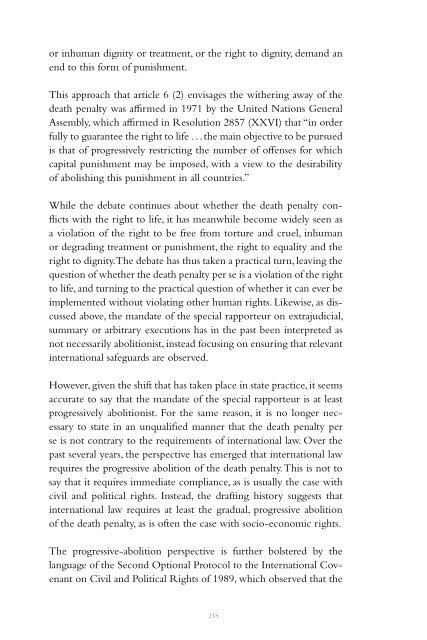PENALTY
DBk0302s7Xm
DBk0302s7Xm
Create successful ePaper yourself
Turn your PDF publications into a flip-book with our unique Google optimized e-Paper software.
or inhuman dignity or treatment, or the right to dignity, demand an<br />
end to this form of punishment.<br />
This approach that article 6 (2) envisages the withering away of the<br />
death penalty was affirmed in 1971 by the United Nations General<br />
Assembly, which affirmed in Resolution 2857 (XXVI) that “in order<br />
fully to guarantee the right to life . . . the main objective to be pursued<br />
is that of progressively restricting the number of offenses for which<br />
capital punishment may be imposed, with a view to the desirability<br />
of abolishing this punishment in all countries.”<br />
While the debate continues about whether the death penalty conflicts<br />
with the right to life, it has meanwhile become widely seen as<br />
a violation of the right to be free from torture and cruel, inhuman<br />
or degrading treatment or punishment, the right to equality and the<br />
right to dignity. The debate has thus taken a practical turn, leaving the<br />
question of whether the death penalty per se is a violation of the right<br />
to life, and turning to the practical question of whether it can ever be<br />
implemented without violating other human rights. Likewise, as discussed<br />
above, the mandate of the special rapporteur on extrajudicial,<br />
summary or arbitrary executions has in the past been interpreted as<br />
not necessarily abolitionist, instead focusing on ensuring that relevant<br />
international safeguards are observed.<br />
However, given the shift that has taken place in state practice, it seems<br />
accurate to say that the mandate of the special rapporteur is at least<br />
progressively abolitionist. For the same reason, it is no longer necessary<br />
to state in an unqualified manner that the death penalty per<br />
se is not contrary to the requirements of international law. Over the<br />
past several years, the perspective has emerged that international law<br />
requires the progressive abolition of the death penalty. This is not to<br />
say that it requires immediate compliance, as is usually the case with<br />
civil and political rights. Instead, the drafting history suggests that<br />
international law requires at least the gradual, progressive abolition<br />
of the death penalty, as is often the case with socio-economic rights.<br />
The progressive-abolition perspective is further bolstered by the<br />
language of the Second Optional Protocol to the International Covenant<br />
on Civil and Political Rights of 1989, which observed that the<br />
language of Article 6 “refers to abolition of the death penalty in terms<br />
that strongly suggest that abolition is desirable” and underlined that<br />
“all measures of abolition of the death penalty should be considered<br />
as progress in the enjoyment of the right to life.”<br />
This would bring the mandate into line with most global human<br />
rights organisations, the Secretary-General of the United Nations,<br />
and the Office of the High Commissioner for Human Rights, all of<br />
which are unambiguous in their calls for the end of at least the practice<br />
of the death penalty. In July 2014, stating that the death penalty “has<br />
no place in the 21st century,” the United Nations Secretary-General<br />
called on states to support the biennial General Assembly resolution<br />
calling for a global moratorium on its application. 12 The language of<br />
these resolutions has been designed to be broad and inclusive, calling<br />
not for the abolition of the death penalty but for a moratorium on<br />
executions with a view to future abolition. The goal of these General<br />
Assembly resolutions thus fits the pattern described above—progressive<br />
abolition.<br />
A moratorium does not completely solve the problem of the death<br />
penalty. The Special Rapporteur on torture and other forms of cruel,<br />
inhuman and degrading treatment or punishment has expressed the<br />
view that lengthy detention on death row, even if a moratorium is in<br />
place, may constitute cruel and inhuman treatment. However, from<br />
the perspective of the right to life, a moratorium is a very helpful<br />
step forward; it allows the sometimes lengthy processes of legal and<br />
constitutional reform to take place without further loss of life.<br />
Each iteration of the General Assembly resolution has been passed<br />
by a wider margin, reflecting the progressive global movement away<br />
from the death penalty. In 2014, 117 states voted in favour of the<br />
resolution, an increase from 111 in 2012, 109 in 2010, 106 in 2008<br />
and 104 in 2007. 13<br />
The ways in which states vote on United Nations moratorium resolutions<br />
has been taken into account in several instances. For example,<br />
12 UN News Service, “Death penalty has no place in 21st century, declares UN chief”, 2 July<br />
2014, available from www.un.org/apps/news/story.asp?NewsID=48192#.U_WzhsWSySp.<br />
13 The most recent of these resolutions, General Assembly Resolution 69/186, was adopted in<br />
December 2014.<br />
218 219


